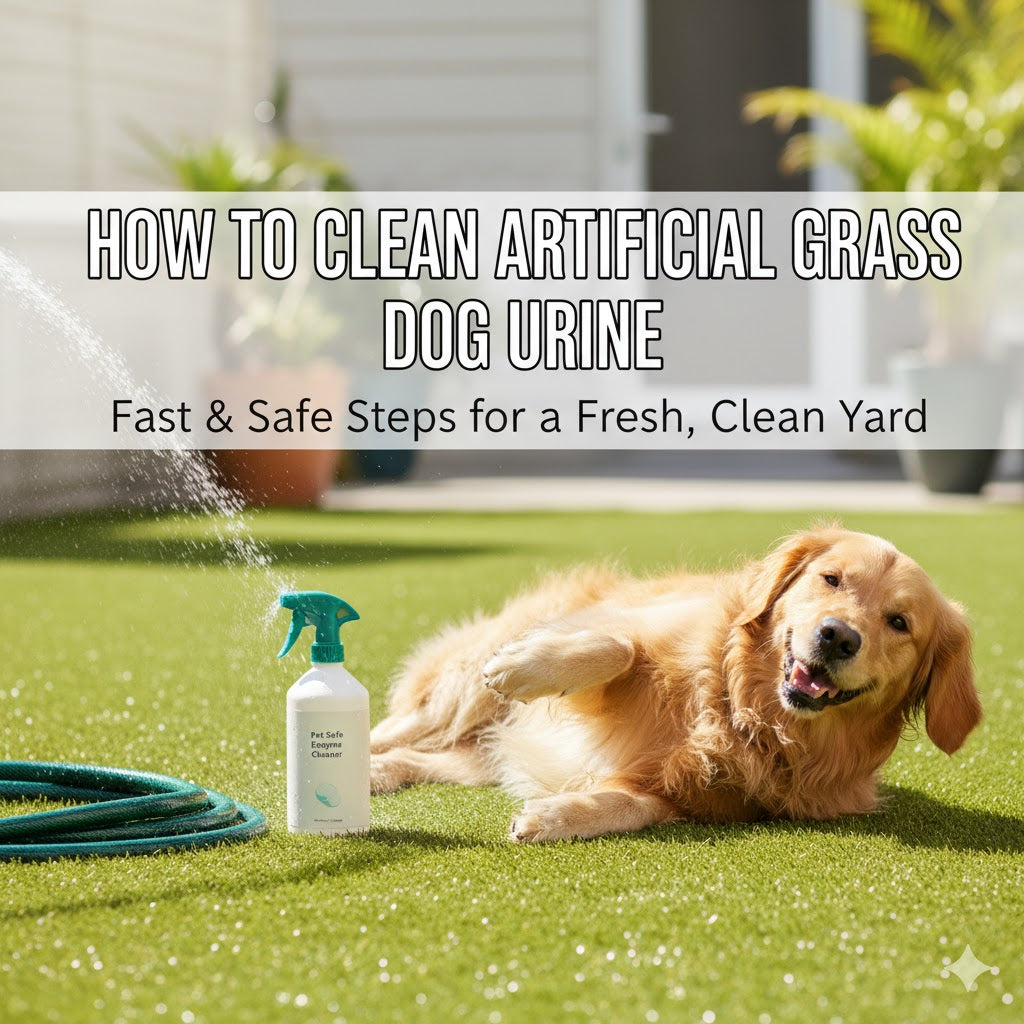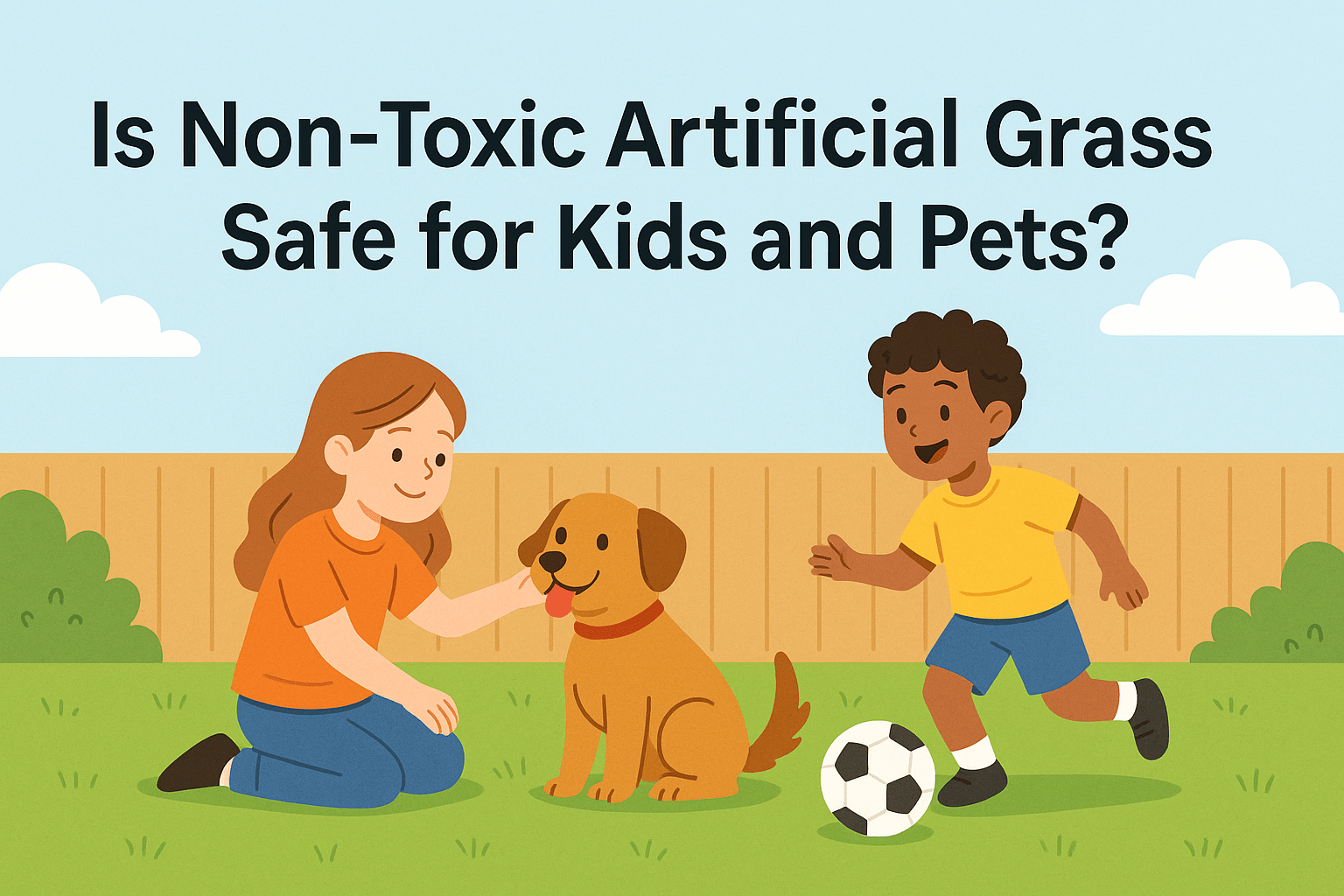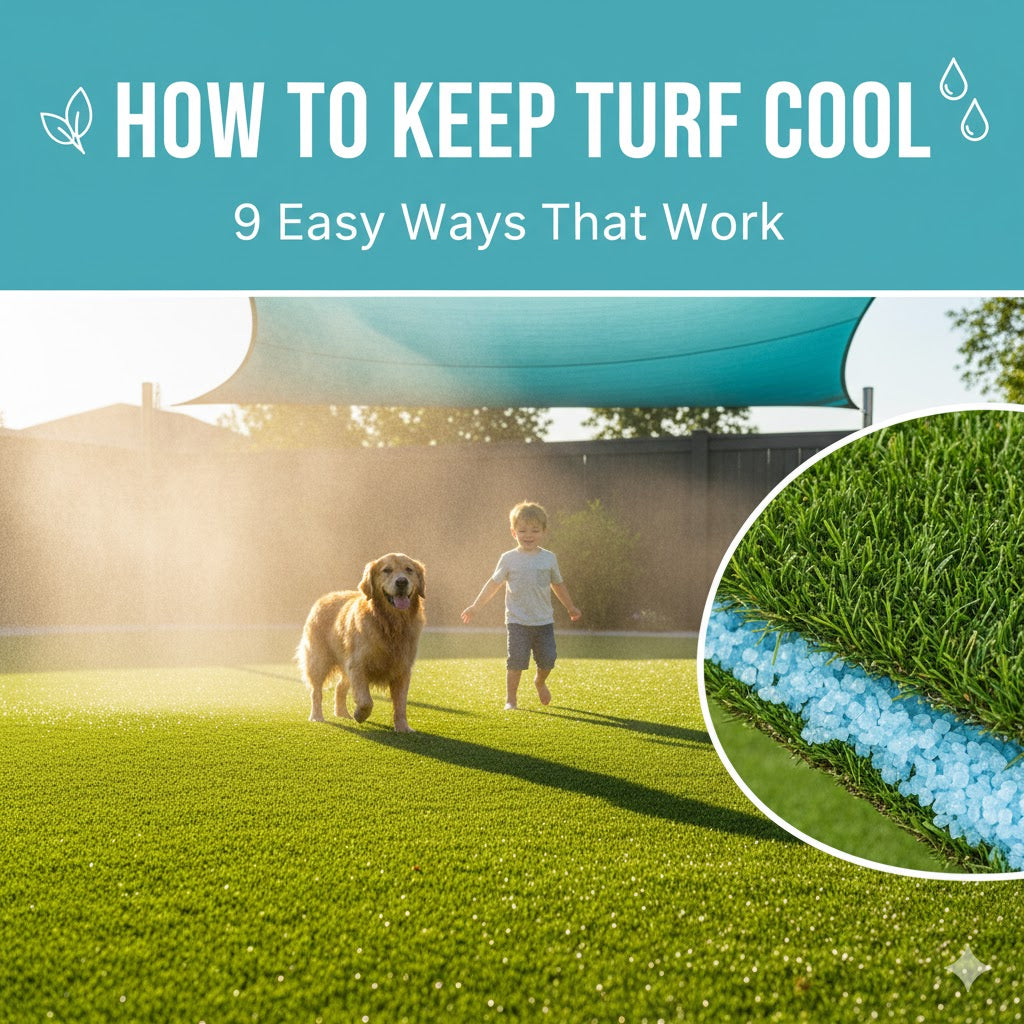Dog owners love artificial grass because it stays green and is easy to care for. But there’s one common problem that is dog urine. Over time, dog pee can leave a strong urine smell on your turf. This makes it hard to enjoy your outdoor space.
Cleaning artificial turf is not hard. With the right routine, you can keep your lawn fresh and safe for pets. You don’t need harsh chemical products. Simple tools like a garden hose, enzyme-based cleaners, and turf deodorizer will do the job.
In this guide, you’ll learn how to clean artificial grass dog urine step by step. We’ll cover quick cleanups, deep cleaning, and long-term prevention. You’ll also see mistakes to avoid and tips for keeping your turf healthy. Follow these steps, and you’ll enjoy a clean, odor-free lawn again.
Why Artificial Grass Smells After Dog Pee
Dog urine contains urea, a waste product that breaks down into ammonia. Ammonia is the sharp odor most people smell on hot days.
Natural grass has soil microbes that break down pet urine. Synthetic turf does not, so urine stays on the surface and in the infill.
Uric acid crystals make the problem worse. These crystals cling to the blades and backing of artificial grass, and plain water cannot remove them. When the turf heats up, the crystals release more ammonia, and the smell returns even after rinsing.
Drainage also plays a big role. Quality artificial turf has a base and backing that let liquids pass through. If the base is weak or a weed barrier traps moisture, urine pools underneath the turf. Bacteria then grow in these wet spots, creating stronger odors over time.
So the main causes are ammonia, uric acid crystals, poor drainage, and bacteria growth.

Quick Clean: How to Clean Artificial Grass Dog Urine in Minutes
Need a fast fix for dog urine smell on artificial grass? Here is how to clean artificial grass dog urine quickly and safely. Use simple tools like a garden hose, a spray bottle, and enzyme-based cleaners.
Steps
1. Remove pet waste (solids).
Pick up solids right away so they do not spread into the blades. If it is messy, scoop first, then treat the spot.
2. Hose flush: 30–60 seconds to push urine through backing.
Use the garden hose on a steady flow. Rinse the area for at least half a minute to dilute and move urine through the turf backing. Do not let it pool.
3. Enzyme spray: saturate, keep wet for label dwell time.
Fill a spray bottle with an enzyme-based cleaner and soak the spot. Keep it wet for the full dwell time on the label, usually 10 to 30 minutes. Enzymes with live bacteria break down urine that water cannot.
4. Light rinse + air dry; brush fibers upright.
Give the area a light rinse to remove residues. Let it air dry in the sun, then brush the fibers upright with a turf rake or scrub brush for airflow.
5. Side note: baking soda for mild lingering odor.
For a light smell, sprinkle baking soda, wait 15–20 minutes, then sweep. Use it sparingly. It helps surface odor, but enzymes do the real work.
Deep Clean & Odor Reset
Sometimes the quick clean isn’t enough. You need a deep reset when your pet turf or synthetic turf keeps reeking. Below is when you should do it, how, and tips to avoid mistakes. Use the term how to clean artificial grass dog urine once in this section.
When to do it
- Persistent urine smell that returns after every rinse.
- Hot or humid weather causes uric acid crystals to reactivate and smell again.
- Multi-dog homes or high traffic, where many pees concentrate in small areas.
Full Process (step by step)
1. Pre-vacuum debris; hose pre-rinse
Use a shop vac or blower to remove leaves, hair, and dust. Then spray the entire area with a garden hose to flush out loose particles.
2. Saturation enzyme soak (2 passes on hotspots)
Use a strong enzyme-based cleaner. Apply it heavily so fibers + infill are soaked. Let it dwell per label time. On stubborn zones, repeat a second pass.
3. Optional disinfect (pet-safe disinfectants) after illness
If your dog was sick or had diarrhea, apply a pet-safe disinfectant (compatible with turf) after enzyme treatment. Follow instructions and rinse afterward.
4. Dry thoroughly; turf deodorizer as topper
Let turf dry fully (air + sun). Then sprinkle a turf deodorizer or antimicrobial infill as a “top coat” to support longer odor control.
5. Caution on power washing: gentle only; avoid seams/backing
If you use a pressure washer, use very low PSI, fan tip, and do not aim directly at seams or backing. High pressure can harm turf backing, loosen seams, and displace infill.
Troubleshooting
|
Problem |
Likely cause / fix |
|
Smell after rain |
Poor drainage or base issue beneath turf |
|
Only specific patches stink |
Infill is wrong in those spots; swap infill locally or reapply enzyme + deodorizer |
Don’t just mask smells. Deep clean + good infill + drainage fixes will make the odor stop for good.

The Drainage & Infill Equation
To keep your artificial lawn working well with dogs, the base layers and infill are just as crucial as surface cleaning.
Why backing and base drainage matter
Your synthetic turf has a backing—often made of polyurethane—which is more water-resistant and less absorbent than older latex backing. Polyurethane backing helps maintain strength and resist water damage.
Under that backing sits a drainage-enhancing turf base (compacted rock, gravel, decomposed granite). This layer must allow water and urine to pass freely downward. If the base is dense or clogged, liquids will pool and stink.
Weed barrier caution
Some installations place a weed barrier directly under the turf carpet. If that barrier is non-porous, it can block urine from draining. That traps odor underneath. Best practice: use a permeable weed control solution or place the barrier lower in the subsoil, not immediately under turf.
Infill choices for odor control
- Avoid plain sand or crumb rubber in pet zones: these materials can trap liquid and create odors.
- Opt for antimicrobial infill or zeolite-type odor absorbers (e.g. products with Microban technology). These infills absorb ammonia and resist bacterial growth.
- Many infill brands infuse Microban antimicrobial technology into their coating so bacteria, mold, and odors are suppressed lifelong.
Application guidance
Follow the manufacturer’s guidance for coverage (often in pounds per square foot). After spreading infill, brush it evenly with a plastic tine rake so it settles and doesn’t clump. That ensures good drainage, fiber support, and odor resistance.
If you’re choosing turf or replacing infill, suppliers like LITA Grass offer pet-friendly options with PU backing, zeolite infill, and permeable weed barriers that support odor control and durability.
Prevention Plan & Regular Care Schedule
A solid prevention plan is the best way to avoid constant deep cleaning. Regular care makes your artificial grass last longer and keeps smells under control. For replacements or maintenance supplies, LITA Grass provides turf grooming equipment, seam tape, and infill that help pet owners keep synthetic turf in top shape.
Here’s a simple schedule you can follow for any pet turf. This is also a key part of how to clean artificial grass dog urine the right way.
Daily / After pees: Give the spot a quick rinse with a garden hose. This stops pet urine from drying and forming crystals that release odor.
Weekly: Apply enzyme cleaner on common pee areas. Use a grooming equipment brush or rake to lift the pile and redistribute infill.
Monthly: Treat the whole turf zone with enzyme solution. Add synthetic turf infill where fibers look matted or low.
Quarterly / After illness: Disinfect the surface with a pet-safe disinfectant or kennel-grade option. Always confirm it’s approved for synthetic turf systems.
Inspections: Check seams, edges, and high-traffic areas. Small seam repairs done early stop bigger damage later.
Special note: If your turf is installed on pool decks or in tight courtyards, expect more odor from heat and less rain. Use enzyme cleaners more often in these spots.
Biggest Mistakes to Avoid
Some cleaning shortcuts can make turf odor worse. Avoid these mistakes to protect your synthetic turf:
- Over-reliance on vinegar or baking soda. Both may mask smells but won’t remove deep urine crystals.
- High-PSI power washing. This can damage seams, backing, and infill. Gentle rinsing is safer.
- Harsh chemical products. Bleach, ammonia cleaners, or other strong chemicals may stain or weaken fibers. Stick to enzyme-based solutions labeled safe for artificial lawns.
- Weed barrier misuse. A barrier placed directly under turf can trap urine. That creates a hidden odor problem you can’t rinse away.

Health & Safety Notes for Pet Areas
Keeping your turf clean is not just about odor. It’s also about health and safety. Always pick up pet waste right away. Leftovers can carry pathogens that put both pets and people at risk.
In homes with several dogs, plan for periodic disinfection. Some viruses, like Canine parvovirus, can survive on surfaces for months. That’s why you need pet-safe disinfectants designed for turf. Choose products that disinfect without harming fibers or infill.
After using disinfectants, rinse away residues with a hose. Allow the turf to dry fully before letting pets back on. Always follow the label instructions for safety and proper dry time.
Conclusion
Artificial grass is a great choice for pet owners, but dog pee can create odor if ignored. The good news is that simple steps prevent big issues. Rinse spots quickly, use enzyme treatments regularly, and maintain the right infill and drainage. With routine care, your turf will stay clean, safe, and odor-free.
Knowing how to clean artificial grass dog urine gives you confidence to keep your yard fresh. Follow these steps to keep your artificial lawn healthy and ready for you and your dog.
If you’re a pet owner, LITA Grass can help with turf, infill, and even installation. Their pet-friendly products make odor control easier from day one. Contact us Today.



Leave a comment
This site is protected by hCaptcha and the hCaptcha Privacy Policy and Terms of Service apply.